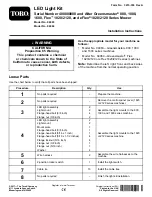
26
S
ection
6— M
aintenance
& a
djuStMentS
1.
Pivot the operator’s seat forward and clean the reservoir
cap and the area around the cap to prevent debris from
contaminating the transmission oil. See Figure 6-5.
Figure 6-5
2.
Turn the reservoir cap counterclockwise to re-move, then
check the oil level in the reservoir. Oil should be visible at
the bottom of the cup, but the oil level must NOT be above
the “FULL COLD” line. See Figure 6-5. DO NOT FILL THE
RESERVOIR.
3.
If necessary to add oil because of some type of leakage, use a
quality 20W50 motor oil and add only enough oil to bring the
level to the “FULL COLD” line. Reinstall the cap and fully tighten.
NOTE:
Prior to the initial operation of the tractor, the
oil level in the reservoir may be slightly higher than the
maximum due to air in the oil lines. Operation of the tractor
will eventually purge the air from the lines and the oil level
will settle to the maximum.
Tractor Storage
1.
Change the engine oil and filter following the instructions
provided in the engine manual packed with this manual.
WARNING!
Never store the tractor with fuel in the
tank indoors or in poorly ventilated enclosures, where
fuel fumes may reach an open flame, spark or pilot
light as on a furnace, water heater, clothes dryer, etc.
2.
If storing the tractor for 30 days or more:
a. To prevent gum deposits from forming inside
the engine’s carburetor and causing possible
malfunction of the engine, the fuel system must be
either completely emptied, or the gasoline must be
treated with a stabilizer to prevent deterioration.
WARNING!
Fuel left in the fuel tank deteriorates
and will cause serious starting problems.
b. Using a fuel stabilizer such as
STA-BIL®
for storage
between 30 and 90 days:
•
Read the product manufacturer’s instructions
and recommendations.
•
Add to clean, fresh gasoline the correct
amount of stabilizer for the capacity
(approximately 3 gallons) of the fuel system.
•
Fill the fuel tank with treated fuel and run the
engine for 2-3 minutes to get stabilized fuel
into the carburetor.
c. Emptying the fuel system for storage of more than
90 days:
•
Prior to putting the tractor in storage, monitor
fuel consumption with the goal of running
the fuel tank empty.
•
Run the engine until it begins to stall. Use the
choke to keep the engine running until all fuel
in the carburetor has been exhausted.
•
Referring to the engine manual, drain the fuel
from the carburetor bowl.
3.
Clean the engine and the entire tractor thoroughly.
4.
Fully charge the battery, then disconnect the negative
cable at the battery to prevent possible discharge.
Recharge the battery periodically when in storage.
NOTE:
Remove the battery if exposed to prolonged periods
of sub-freezing temperatures. Store in a cool, dry location
where temperatures are above freezing.
5.
Lubricate all lubrication points.
NOTE:
Using a pressure washer or garden hose is not
recommended for cleaning your tractor. It may cause
damage to electrical components, spindles, pulleys,
bearings or the engine. The use of water will result in
shortened life and reduce serviceability.
Removing The Tractor From Storage
1.
Check the engine oil.
2.
Fully charge the battery and inflate the tires to the
recommended pressure.
3.
Fill the fuel tank with clean, fresh gasoline.
4.
Start the engine and allow to idle for a few minutes to
ensure engine is operating properly.
5.
Drive the tractor without a load to make certain all the
tractor systems are functioning properly.
Adjustments
WARNING!
Shut the engine off, remove the
ignition key and engage the parking brake before
making adjustments. Protect your hands by using
heavy gloves when handling the blades.
Deck Leveling
NOTE:
Check the tractor’s tire pressure before performing
any deck leveling adjustments. Refer to Tires for information
regarding tire pressure.
Leveling the Deck (Side-to-Side)
NOTE:
Check the tractor’s tire pressure before performing any deck
leveling adjustments. Refer to Tires for information regarding tire
pressure. Always level the deck side-to-side before front to rear.
If the cutting deck appears to be mowing unevenly, a side-to-
side adjustment can be performed. Adjust if necessary as follows:
Summary of Contents for Z-Force SZ
Page 37: ...Notes 11 37 ...















































